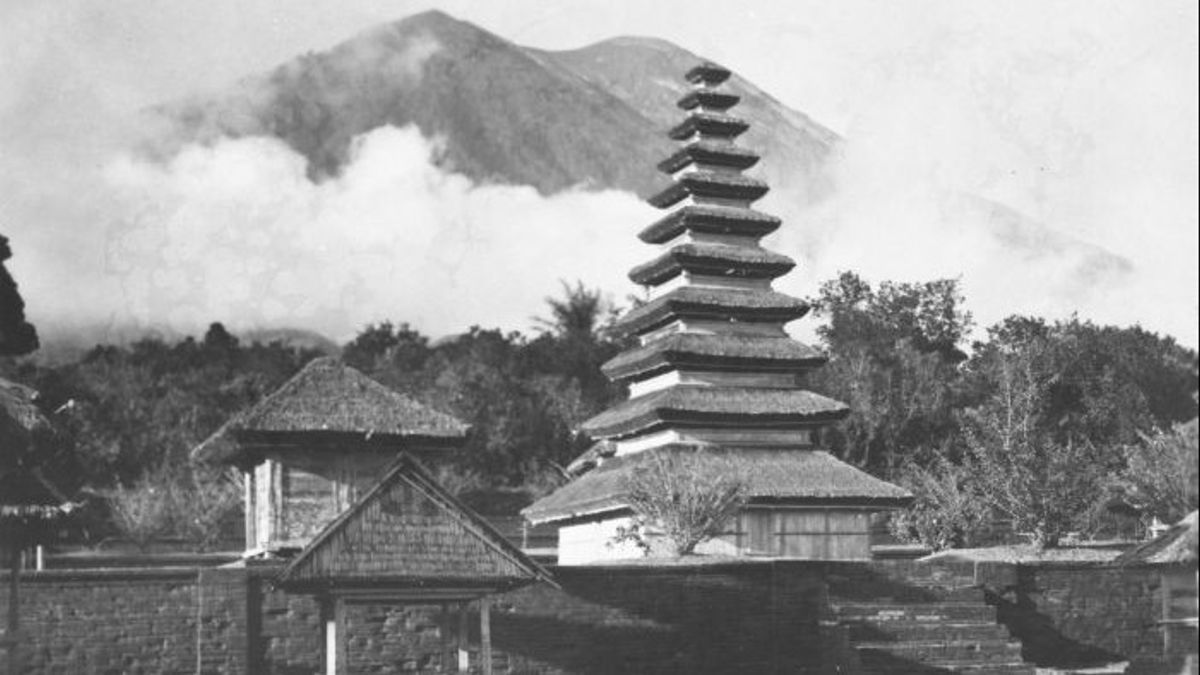JAKARTA - Mount Agung is a form of charm from the island of Bali. Even though it is only 3,031 meters high, Mount Agung has long been considered the center of Balinese civilization. People call it the eternal place of the gods. In 1963, Mount Agung erupted. The disaster killed thousands of lives. The repercussions are long. Millions of other people are starving.
Historically, Mount Agung is considered sacred by the Balinese people. Pura Besakih around Mount Agung is proof. The temple is believed to be an intermediary place for the gods to the top of Mount Agung. The peak is often symbolized as the palace of the gods. Even though the Balinese live on an island, they are more familiar with the mountains than the sea.
"But a much more important reason is because Bali's social space is governed by a cosmos arranged hierarchically, based on the complementary contradiction between the 'upper world' (kaja), encompassing Mount Agung as a sacred mountain, the source of fertility and life, the dwelling place of the gods and deified ancestors. And the 'underworld' (kelod), namely the direction of the sea, where the demons are, marked by diseases and death, "Michel Picard, in the book Bali: Cultural Tourism and Tourism Culture (2006).

Thanks to Mount Agung, the land around the main slopes is fertile. By local farmers, Balinese land is widely used for farming. The charm of Bali and Mount Agung was also described by Lieutenant Governor of the Dutch East Indies, Thomas Stamford Raffles (1811-1816). Raffles said that the island of Bali is an interesting place and has the same mineral composition as the island of Java.
“It has the same climate and the same land, has mountains of a proportional height and a balanced river flow. Suitable for irrigation purposes, it attains the same fertility rate, but has a coast surrounded by iron sand, no good harbors or harbors, is within a large measure and does not derive figures from external trade, especially with traders on board -a large ship, "wrote Raffles in his masterpiece The History of Java (1817).
The impact of the eruption of Mount AgungApart from exuding beauty, Mount Agung once reached the darkest period in Balinese history. That was when Mount Agung erupted since 1800, 1802, 1821, 1843, until the worst was 1963. The eruption of Mount Agung on March 17, 1963 was the most violent eruption in the history of Bali Island.
The victims were in the thousands. The thunderous eruption was believed to be the end of the world by local residents. Moreover, after that the island of Bali encountered other problems, such as pest attacks, crop failure, and bubonic plague.

“Mount Agung on the island of Bali erupted preceded by extraordinary activities. This national natural disaster has caused thousands of casualties and enormous property of the people. Help has been given not only from the government, but from other Indonesians, but also from all corners of the world, ”wrote a report from the Mimbar Information Magazine (1963).
The eruption of Mount Agung left 1,549 people dead, 1,700 houses destroyed, 225 thousand people lost their livelihoods, and 100,000 people had to be permanently displaced. Another impact, eight bridges were destroyed and an estimated 316,518 tons of food production were destroyed.
The eruption also caused the earth to experience a decrease in temperature (an average of 0.4 degrees Celsius). The impact of a decrease in temperature due to the eruption of Mount Agung at that time was equivalent to that of the eruptions of Mount Tambora (1815) and Mount Krakatau (1883).
Trust being violatedThe Indonesian government at that time was considered responsible for the high loss of life. This is because the government has urged many religious leaders to hold a cleansing ceremony for the magnificent Eka Dasa Rudra at Besakih Temple. In fact, the ceremony should be held every hundred years.
Nevertheless, the government and religious leaders felt the ceremony was necessary because of the bad economic conditions due to the recession in the 1960s. Therefore, the cleaning ceremony is believed to be the savior to obtain the balance of the universe.
“The catastrophe of the eruption of Mount Agung, the highest and most sacred mountain in 1963, is widely seen as the result of Soekarno and other secular figures in determining the time and structure of the ceremony. The mythology of the eruption of Mount Agung in the beliefs of the Balinese Hindu community is considered a bad omen of the destruction of the Balinese earth, "added I Ngurah Suryawan in the book Genealogy of Violence and Upheaval Subaltern: Embers in North Bali (2010).

As a result, the feared eruption occurred in the middle of the ceremony. The eastern part of the island of Bali was immediately destroyed. This condition became a moment that brought Bali into an economic downturn. As a result, many Balinese people have begun to familiarize themselves with poverty and hunger.
"After Mount Agung erupted, the ranks of the urban poor and unemployed swelled greatly. A newspaper report in October 1963 observed that the number of beggars in the cities was increasing every day. They left their hometown, which was suffering from economic famine, and came to the city to beg, "concluded Geoffrey Robinson in the book The Dark Side of the Island of the Gods: The History of Political Violence (2005).
* Read other information about HISTORY OF NUSANTARA or read other interesting writings from Detha Arya Tifada.
MEMORY OtherThe English, Chinese, Japanese, Arabic, and French versions are automatically generated by the AI. So there may still be inaccuracies in translating, please always see Indonesian as our main language. (system supported by DigitalSiber.id)









